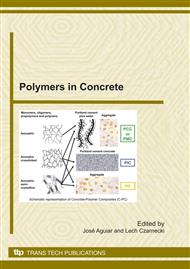p.47
p.57
p.65
p.73
p.85
p.97
p.105
p.115
p.121
Effect of Types and Contents of Polymer Resin on Spalling Prevention of High-Strength Concrete Subjected to Fire
Abstract:
In this study, the fundamental and spalling properties of high-strength concrete were examined, especially when various types and varying content of polymer resin were added. Two types of polymers were used in this study: ethylene vinyl acetate copolymer (EVA-P) and polyvinyl acetate copolymer (PVA-P) as powders and polyvinyl acetate copolymer (PVA-F) and polypropylene copolymer (PP-F) as fibers. Test results showed that the addition of EVA-P and PVA-F to concrete slightly decreased flowability, whereas the addition of PP-F and PVA-P enhanced the viscosity, leading to a remarkable reduction in flowability. The air content of concrete containing EVA-P, PVA-F, and PP-F showed no significant variation. The addition of PVA-P to concrete also caused a slight reduction in compressive strength, whereas the other additives had insignificant effects. After a fire test, the control concrete and concretes with EVA-P, PVA-P, and PVA-F exhibited severe explosive spalling regardless of the dosages. This was because the polymer does not provide sufficient void networks, which is important for vapor evacuation, which enables the release of steam pressure inside the concrete. However, when more than 0.10% of PP-F was added, spalling was effectively prevented. For the residual compressive strength, higher polymer dosage in the concrete produced better results regardless of the polymer type. The powder-type polymers did not contribute to preventing spalling in concrete subjected to fire. This is due to their geometric shape and high melting point. It is concluded that a high aspect ratio and low melting point is critical during polymer selection to prevent spalling in high-strength concrete.
Info:
Periodical:
Pages:
85-95
Citation:
Online since:
January 2011
Authors:
Keywords:
Price:
Сopyright:
© 2011 Trans Tech Publications Ltd. All Rights Reserved
Share:
Citation:


